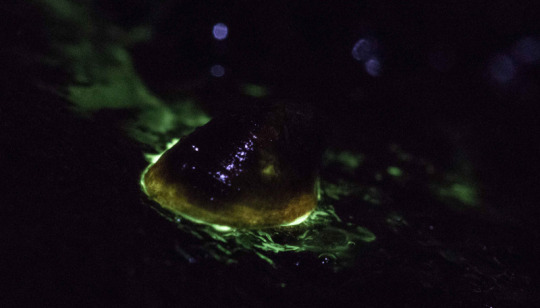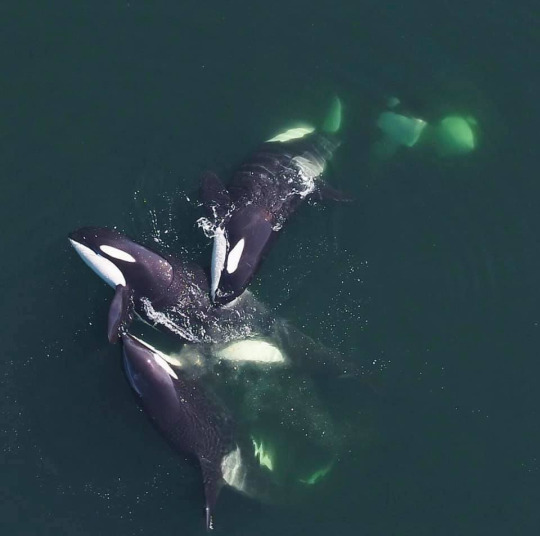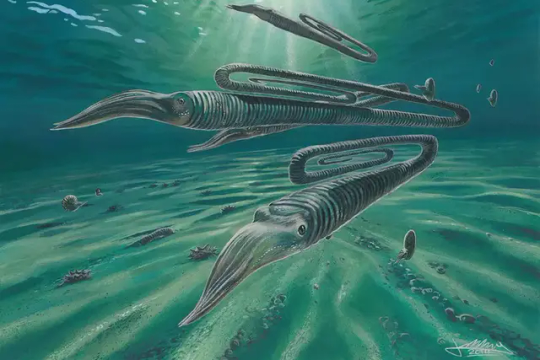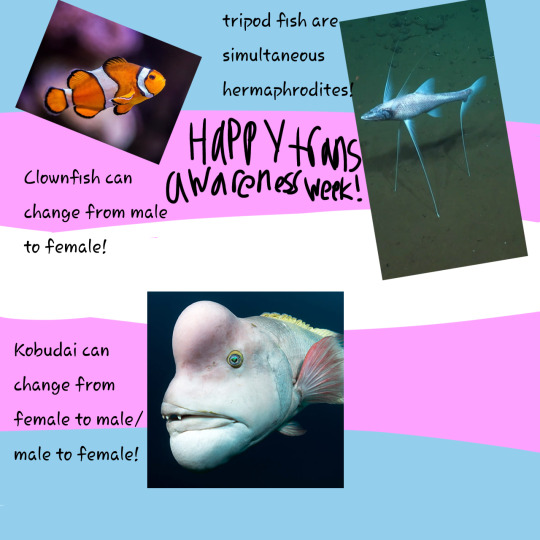Text
Hoping to start posting again now that I have completed my BSc and have a more stable personal life.
That is all. Best fishes -Ray
1 note
·
View note
Text

Looking for a poetic relationship metaphor that's a little more niche? Look no further than the lovely Venus flower basket sponge (Euplectella aspergillum). This diva is a species of glass sponge, meaning that the bodies of these animals contain intricate skeletons of silica spicules. Not every human will be lucky enough to observe these animals in their natural environment due to the fact that their favoured habitat is below 500m in the deep Pacific Ocean. However, following the death of the sponge, the decaying tissues leave only the hard cylindrical structure that resembles an intricate lattice of woven glass. What is even more romantic than the snowflake-like beauty of these creatures is the symbiotic relationship they share with the small crustaceans Stenopodidea. While these tiny beings are commonly known as the "boxer shrimp" and resemble prawns, it is an interesting side note that they are not either. Rather, these decapod crustaceans belong to their very own group. Two Stenpodidea, one male and one female, will inhabit a Venus flower basket sponge's body together. These tenants will help the sponge continue to filter tasty marine snow out of the water by eating extra detritus from the sponge's body, keeping it clean and filtering at max capacity in exchange for the protection provided by the sponge's strong skeleton. However, soon the pair will grow too large to leave their living castle. Luckily, the couple are content to remain within their beautiful prison, for their offspring are small enough to pass through the small openings and into the open water, hopefully to find their own partners and sponge homes.
Stenpodidea's fate is an oddly poetic lifecycle of quite literally mating for life, spending each and every moment together until their shared home becomes their shared tomb. In fact, in some historical Asian cultures the dried skeleton of a glass sponge is given as a wedding gift, representing the loyalty and devotion of the little crustacean couple that once resided there. A physical representation of the human pair's promise of "'till death do us part".
#wet beast wednesday#marine biology#marine life#marine animals#ocean animals#marine zoology#ocean life#sponge#porifera#sea animals#crustacean#decapoda#deep ocean#pacific ocean#aquatic animals#aquatic#sea creatures#aquatic life
7 notes
·
View notes
Text
inspired by boop day, reblog this post if its ok for people to send you random asks and interact on your posts with no judgement. i want to talk to people.
60K notes
·
View notes
Text


Was looking through old pictures from my Marine Animal Diversity course and found this holy image
6 notes
·
View notes
Text

Terrible news everyone! Turns out the 'boymum' phenomenon is not limited to members of the human species. Female orca (Orcinus orca), especially post-menopausal individuals, often seem to spend a large amount of time coddling their useless adult sons. These mothers often share food with their larger sons and solve scuffles between them and other members of their pod. Why do these females dote on their adult sons and not their daughters? Researches believe it is all down to passing on the most of their genetic information. An orca mother only produces one calf per gestation period, a process that takes an average of 17 months and usually only has a calf every 3–5 years. A male however, can mate with multiple females per year. By ensuring their sons are well-fed and avoid fights increases their chances of procreating even more, thereby maximising the amount of individuals in the next generation carrying part of her genetic information.
#marine biology#marine life#marine animals#ocean animals#marine zoology#ocean life#wet beast wednesday#marine mammals#cetacean#cetaceans#Delphinidae#dolphin#Mammalia#Artiodactyla#Chordata#sea animals#sea life#sea creature#sea creatures#ocean
0 notes
Text
By the grace of Davy Jones! One hundred people are following my silly little page! That's enough for a rather impressive display of cyclone feeding, if any of you would care to join me?
1 note
·
View note
Text

Okay, okay. I know this isn't a marine animal but I recently read about this little beauty and decided that you all should be informed as well. As it turns out the 'normal looking guy who is secretly kind of a freak' trope is not exclusive to the human species. This unassuming 11cm gastropod has a hidden talent, it is possibly the only freshwater snail known to science with the ability to produce bioluminescence. Like most 'limpets', the luminescent limpet (Latia) absolutely love scraping organic matter and algae off rocks. This amazing specimen however, can generate a glowing slime as a defense mechanism when disturbed. They are also real homebodies, only being found in stony stream systems of the north island (Te Ika-a-Māui) of the country of New Zealand. In between these marvelous critters and the native glow worm (Arachnocampa luminosa) you would be forgiven for imagining the NZ wilderness as some kind of green-tinted nighttime rave. These sensitive little souls however are currently at risk due to declining water quality New Zealand rivers.
Photo: Shaun lee
#wet beast wednesday#molluscs#freshwater#gastropods#snail#zoology#ecology#ecosystem#bioluminescence#bioluminecent
23 notes
·
View notes
Text
University flatting is great. One day I am hopelessly losing hangman to the medical students who keep choosing scientific names to niche illnesses and the next day I am explaining to the same man that Minecraft did not invent nautilus shells.
1 note
·
View note
Text
just learnt that orca families hug and its called a cuddle puddle i will never recover

2K notes
·
View notes
Text

Convergent evolution is the evolution of 'analogous' or similar structures in organisms that are not closely related. Such as the wings of insects, birds and bats. One potential example of this is the Diplomoceras maximum, an extinct squid-like creature who is clearly analogous to, or a distant cousin of Clippy the paperclip. This amazing creature lived 68 million years ago, with the most notable fossil found at the cephalopod rich López de Bertodano Formation of Seymour Island, Antarctica. An area that was formerly warmer before further movement of tectonic plates. The fossil shell measured an impressive 1.5 metres and is formed from ridges, speculated to grow a section annually. These ribs are thought be similar to tree rings, being used for dating samples and gaining insight about the environment of the prehistoric sea, such as measuring the carbon and oxygen isotopes in the shell. Paleoart by James McKay
#marine biology#marine life#marine animals#ocean animals#marine zoology#cephalopods#molluscs#paleontology#fossils#ocean#wet beast wednesday#marine ecosystem#marine#zoology#animal facts#animalia#animal#sea animals#sea creature#sea creatures#sea life#ocean life
205 notes
·
View notes
Text
Hello, I am completely normal about sharks and definitely won’t go on an hour long emotional tangent about how they mean everything to me
314 notes
·
View notes
Text

Ever made one of those charming little tin can phones? Turns out there is a marine equivalent, sort of. A SOFAR (Sound Fixing and Ranging) channel occurs due to the stratification of the ocean, the most dense water which is cold and saline sinks and warmer, fresher water stays at the surface. This drives the entirety of the global ocean conveyor belt, a massive scale system of currents upwelling, downwelling and moving with the gradients. The intermediate layer has been used by naval ships to send and receive audio information since the second world war as the sound can travel thousands of miles in the empty ocean due to the fact that the sound waves bounce off the boundaries of the neighboring layers without dispersing, like when a human cups their hands over their mouth to call out. Scientists have made record of strange low-frequency noises traveling through the channel, these are theorised to be caused by fin whales (Balaenoptera physalus) diving down to make use of these natural telephones to communicate with other whales from vast distances.
#marine biology#marine life#marine animals#ocean animals#marine zoology#ocean#oceanlife#ocean life#sea creatures#wet beast wednesday#cetaceans#whales#oceanography
6 notes
·
View notes
Text
not now sweetie i'm looking at the wikipedia article for humpback whales
702 notes
·
View notes


